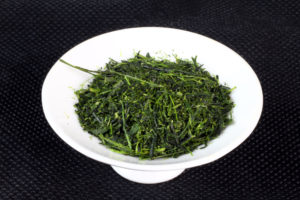Ikkyu Tea has different types of sencha on their site. This is one of them.
As with their other sencha, Ren is a Japanese first name.
Tea farmer Shimono Koki blends four types of cultivars for this sencha: Yutakamidori, Yabukita, Saemidori, and Asatsuyu.
This tea comes from the first harvest and is made in Kagoshima prefecture.
Lets brew this green tea
The leaves have an excellent aroma.
It’s deeply creamy and sweet, just like a shincha or gyokuro. I also find it to be very fresh.
My four-year-old daughter, Abril, wanted to smell the tea leaves too. I’m training her so that she’ll be a good tea taster one day.
She said that “it smells delicious”.
Unfortunately, some of the tea leaves are broken down.
But the ones that aren’t are definitely high quality leaves. They have a good color, size and shape.
Now I’m ready to infuse 4 grams of this tea in 60 ml (2 oz) of water at 80ºC (176ºF) for one minute.
The wet leaves have an aroma that’s vegetal and marine. Perhaps it is a little sweeter than usual.
Once served, we have an intense green liquor with some sediments.
I hope that it tastes as good as it looks.
The most powerful taste is the umami. It feels as if it was a gyokuro.
This tea also feels sweet, with tones of seaweed. It has a long aftertaste.
I don’t feel any bitterness at all.
What comes to mind is a good, classical sencha.
Abril’s opinion: “It’s good”.
After that, she went to play somewhere else. It doesn’t look like she’ll be participating in this tea tasting anymore.
Then I made a second infusion with the same parameters.
It still has umami taste, but it is lighter.
While it’s slightly astringent and bitter, I liked it.
I imagine that it will be okay if I made a third infusion in the same manner.
It is actually very similar to the second one.
And to wrap things up, I made the last infusion with boiling water for 10 seconds.
It was light in taste but refreshing.
This blend has a familiar taste, and I just noticed why.
Yutakamidori comes from Asatsuyu, and Saemidori is a hybrid of Asatsuyu and Yabukita.
In other words, the four cultivars are somewhat similar.
But it’s certainly something I like, a balanced sencha with a bold umami taste.
Here’s the link to the product page in case that you want to try it.






